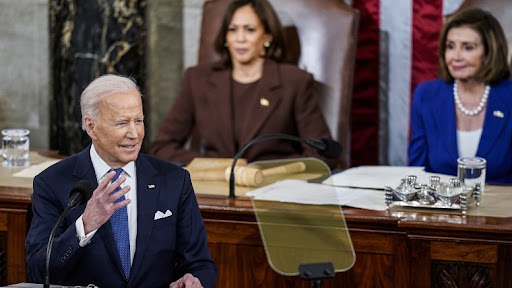Biden Delivers First State of the Union

Image Courtesy of NBC
By Jeremy Perillo
President Joe Biden delivered his first State of the Union address to a joint session of Congress on Tuesday, March 1, 2022, highlighting key legislative priorities, and setting an agenda outlook for the upcoming year. As Biden’s administration faces many issues both domestically and across the globe, from Russia’s invasion of Ukraine to the effects of inflation on millions of Americans, the State of the Union served as an opportunity for Biden to address those issues and chart a path forward.
Like in most midterm elections, the Democrats, as the majority party, are facing a daunting challenge to maintain their hold of Congress, particularly in the House. Thirty-one House Democrats are retiring or seeking other offices, a possible sign that the future for House Democrats may not be positive, with Biden’s favorability trailing at around 40%, not calming Democrats’ concerns.
Presiding over Biden’s second address to a joint session of Congress were Vice President Kamala Harris, and Speaker of the House Nancy Pelosi. Depending on how the 2022 midterm elections play out, this may be the last time Biden will have two friendly faces sitting behind him for the remainder of this presidential term, as the House is charted to flip from a Democrat to a Republican majority.
President Biden’s speech focused on “four buckets” – the world stage, economic vision, Covid-19, and the future of America. All aspects related to the overall theme of the speech, “building a better America,” with a message of optimism.
Biden’s address started strong, both for him as an orator and in a show of bipartisan applause. No doubt in the past couple of weeks, Biden’s speechwriting team has had to scramble to include the administration’s response to Russia’s aggression and parlay next steps. While the Ukrainian Ambassador to the U.S. was met with thunderous, bipartisan, applause, Biden asserted a continually aggressive approach towards Russia and its oligarchs by NATO and the West.
“He [Putin] thought the West and NATO would not respond. He thought he could divide us at home in this chamber and this nation,” Biden said. “And he thought he could divide us in Europe as well. But Putin was wrong. We are ready. We are united.”
As Biden moved away from Ukraine, Biden tucked into more of his legislative agenda. He touted the American Rescue Plan and the bipartisan infrastructure package as two successes of his administration so far and highlighted the effects that Americans have already been seeing. Inflation, a significant issue for Americans, was discussed, but not as much as one might think. Biden tied the necessity to create better-paying jobs and bring manufacturing back to the U.S., as avenues to solve the inflation issue.
“We have a choice. One way to fight inflation is to drive down wages and make Americans poorer,” Biden said. “I think I have a better idea to fight inflation: Lower your costs, not your wages. Make more cars and semiconductors in America. More infrastructure and innovation in America.”
Biden spent a significant portion of his speech advocating for various pieces of legislation and Congressional actions. He asked Congress to: reform the tax code and ensure that “corporations pay their fair share,” confirm his federal reserve nominees, cap prescription drug prices like insulin, higher the minimum wage, ensure legal protections for those who identify as LGBT, and codify abortion rights. He also advocated for various individual pieces of legislation like the Paycheck Fairness Act and the bipartisan Innovation Act.
Those items received ovations mostly from Democrats, with Republicans indulging here and there. This is to be expected at an event like the State of the Union: the partisan President announces a relatively partisan agenda. However, Biden did invoke bipartisanship and catered to less liberal Americans. Biden boldly distanced himself from the defund-the-police movement.
“The answer is not to defund the police,” he said. “The answer is to fund the police with the resources and training they need to protect our communities.”
He closed the speech with his “unity agenda,” four areas where he sees a common desire to get something done. He highlighted a desire to maintain reforms related to the opioid epidemic, mental health (particularly related to social media), veterans, and cancer.
Like every State of the Union, Biden ended with a strong, uplifting sentiment about the country. The state of the union was strong, “because you, the American people, are strong. We are stronger today than we were a year ago. And we will be stronger a year from now than we are today.”
Iowa Governor Kim Reynolds delivered the Republican response to Biden’s address, bringing attention to issues and talking points they find important to bring to the American people. Her message was simple, in that Republicans did not have to look to highlight grievances Americans may have towards Democratic leadership over the past year. She discussed the botched withdrawal from Afghanistan, inflation, crime, controversial Covid-19 measures, encroachment on education, and political correctness.
In addition to Reynolds’s response, several Democrats also offered responses. Representative Rashida Tlaib (D-MI), giving her response on behalf of the Working Families Party, will focus on Biden’s Build Back Better agenda and the damage moderate Democrats, like Senator Joe Manchin (D-WV), have caused to it. It was also reported that Rep. Colin Allred (D-TX) was to deliver the Congressional Black Caucus response and Rep. Josh Gottheimer (D-NJ) was set to speak on behalf of the bipartisan group No Labels.
Having multiple responses outside the direct representative of the minority party of the president, is a rarity, although not completely unprecedented. Republicans have had multiple members giving responses since at least 2011, when Tea Party Express, a PAC for the tea party, began giving a response to the State of the Union in addition to the traditional Republican response. Senator Rand Paul (R-KY) delivered the tea party response in 2011 and then-Representative, now Senator, Mike Lee delivered the response to Obama’s 2014 State of the Union.
The State of the Union is an event that has turned into partisan pageantry. So much so that many Americans do not tune in. Roughly 10 to 15 percent of the country tunes in any given year to watch the president’s address, with that 10 to 15 percent made of dedicated American partisans. Meaning that they likely have their minds made up what they think of the President, policy, the majority party, etc. Regardless, the Biden administration offered a multitude of options to turn the tide on a presidency with sagging approval numbers. Will they rise to the challenge in the next year as Democrats in Congress prepare to lose the majority?







